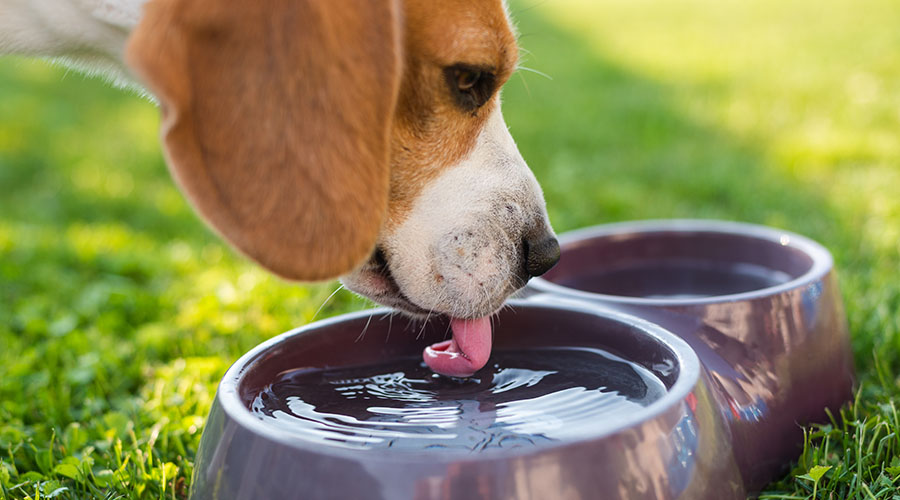Yes, they lap. But what does that mean?
By Taryn MacKinney | August 24, 2023

The backwards “ladle” of a dog’s tongue looks like it scoops water. It doesn’t.
My dog, Lacey, is a messy drinker. Each time she laps, she shoots water out each side of her mouth, leaving puddles on the floor. The only evidence I have that some water makes it down her gullet is that she hasn’t died.
Lacey’s problem stems from a system bug shared by all canines. Dogs lack complete cheeks, that all-important feature that lets many animals, like horses and humans, close their mouths most of the way, creating a seal to suck up water. You can turn your mouth into a straw; dogs cannot.
Evolutionarily, going mostly cheekless makes sense for dogs, cats, and other predators. Without excess skin, they can bite and hold prey with more force, using even their back teeth. So, our carnivorous pets must lap instead of suck — but what that actually means was a mystery until a little over a decade ago.
It wasn’t sloppy dogs that first caught scientists’ eye — it was clean, posh cats. In 2010, researchers from MIT, Virginia Tech, and Princeton made an unusual discovery. Rather than using its tongue like a spoon to scoop water into its mouth, a cat flicks its tongue against the surface of the water and then yanks it back, dragging up a column of water with it. The cat closes its mouth around the top of the column, nipping off a little water, which the back of the cat’s tongue shuffles along grooves on the top of the mouth. As the front of the tongue keeps lapping, those grooves act like a conveyor belt, pushing the water toward the throat.
“The main feature they use during this lapping behavior is high acceleration,” says physicist Sunghwan Jung, an author on the 2010 study who is now at Cornell University. “So their acceleration should of course be more than G, gravity, to withdraw the water.”
In other words, a cat “exploits fluid inertia to defeat gravity” — so gushes the 2010 paper.
But the team still thought dogs scooped water. After all, a dog’s tongue curls backward into a ladle shape as it laps, and in slow-motion videos, you can spot liquid in the cup of the tongue. Case closed!
Until the next year, when Harvard researchers X-rayed dogs drinking and realized that they were doing what cats did — albeit in a messier way. “We conclude that cats and dogs share the same basic mechanism,” they wrote. “Liquid adheres to the dorsal surface of the backwardly curled tongue tip.”
What about the water the dog scoops into its backwards ladle? That water ends up underneath the dog’s tongue — a problem for pooches, since water must be above the tongue to be swallowed. “For humans, if you have water underneath your tongue, you can close your mouth and just push the water above your tongue,” Jung says. Not so for cheekless dogs — that water simply dribbles out.
So why do dogs bother to curl their tongues at all? In 2015, researchers at Purdue University and Virginia Tech, including Jung, took a closer look. They filmed 19 dogs drinking, from a Yorkshire Terrier mix to a Great Dane, and modeled their drinking using rounded glass rods.
Credit: Gart S, Socha JJ, Vlachos PP, Jung S. Dogs lap using acceleration-driven open pumping. Proc Natl Acad Sci U S A. 2015 Dec 29;112(52):15798-802.
The researchers filmed 19 dogs of different breeds and sizes drinking water.
The team realized dogs’ curled tongues let them drink more water. “If you have a bigger object pulling out of the water, then a large column of water is formed, [and] if you want to make a bigger structure, you're going to curve your tongue and make a very round shape,” says Jung.
In other words, a dog’s curled tongue becomes a kind of piston, which punches the water with a larger area, pulling more water into the mouth. The dog closes its mouth around the top of the water column at just the right time to maximize the amount of liquid — 1 or 2 milliliters per lap, the team found.
There’s another difference between dogs and cats. “With the cat, you’re going to see a little deceleration just before they pull their tongue [into] the mouth,” says Jung. “But if you look at the dog, they maintain their acceleration for a longer time.” A bigger, faster-moving piston makes for a bigger mess.
Jung isn’t sure why dogs and cats do things a little differently. “Maybe it's due to the nature of the animal,” he says. “The cats, they hate water.”
With dogs and cats figured out, Jung — one of a growing number of physicists studying the living world — has turned to a more unusual critter. “We’re looking at the drinking behavior of bats,” Jung says. Less adorable, admittedly, but the physics might be just as weird.
Taryn MacKinney is the Editor of APS News.
©1995 - 2024, AMERICAN PHYSICAL SOCIETY
APS encourages the redistribution of the materials included in this newspaper provided that attribution to the source is noted and the materials are not truncated or changed.
Editor: Taryn MacKinney
October 2023 (Volume 32, Number 10)
Articles in this Issue

